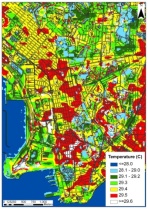Heat Island and Healthy Buildings
Albedo? Heat Island? Solar Reflective Index?
These are some terms floating around the industry relating to environmental health and energy efficiency. The heat generated and absorbed by commercial and industrial areas has a tendency to get trapped in an “island-like” manner surrounding the buildings. These areas can be so much hotter than the surrounding environments that it effects growing seasons, air quality, energy efficiency and ecosystem health. This increase in temperature not only harms the local animal and plant life, but it also makes the buildings’ HVAC and other equipment work much harder than required.
The EPA has reported that, “the annual mean air temperature of a city with 1 million people or more can be 1.8–5.4°F (1–3°C) warmer than its surroundings. In the evening, the difference can be as high as 22°F (12°C). Heat islands can affect communities by increasing summertime peak energy demand, air conditioning costs, air pollution and greenhouse gas emissions, heat-related illness and mortality, and water quality.”
“Summer land surface temperature of cities in the Northeast were an average of 7 °C to 9 °C (13°F to 16 °F) warmer than surrounding rural areas over a three year period, the new research shows. The complex phenomenon that drives up temperatures is called the urban heat island effect.” – Dr Marc Imhoff, NASA
But wait, there is good news! There are a plethora of reasonable efforts that can help lower the impact of spring and summertime heat islands. Some common efforts within the LEED and green building community are white roofs, or roofs with a high albedo or SRI value. Albedo and SRI are related to the ability of a surface to reflect light and heat off and back out of the immediate area. Dark surfaces, such as asphalt and dark roofing material absorbs heat and increase the effect of the dreaded heat island. Buildings concerned about reducing their impact on the heat island may replace their roof with a white material, coat their existing roof with a high SRI value, or even add a garden (green roof)! Not only does this increase the efficiency of the building’s energy systems, but it can increase the air quality and productivity of the micro-climate altogether.


